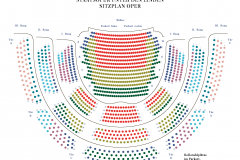Fin De Partie
Mo | Tu | We | Th | Fr | Sa | Su |
OPERA IN ONE ACT (2018)
MUSIC FROM György Kurtág
TEXT FROM Samuel Beckett
Endgame, game over. With four characters. Hamm and his servants Clov. Hamm’s parents Nagg and Nell. A play with rules, rituals, memories, and words. Words that are sung, which has only been rarely done with Samuel Beckett’s texts. György Kurtág’s opera Fin de partie is the only full-length setting of one of his plays.
The Hungarian composer was fascinated by Beckett’s Endgame, which premiered in Paris in 1957, for more than half a century. In 2010, at the age of 85, Kurtág began composing his very first opera, which premiered at Milan’s Scala in 2018. In his musical language, he relies closely on Beckett’s original French text, which he opens to a fascinating space of sound with his delicate instrumentation. Here, Beckett’s predilections for the circus, amusement parks, and clownery resonate, as Johannes Erath foregrounds in his production.
Synopsis
The setting is a house by the sea, where four people reside:
Hamm, an elderly gentleman confined to a wheelchair
Clov, servant to Hamm, who cannot sit down
Nagg and Nell, Hamm's very old parents, each trapped in a dustbin, without legs
The tensions between the four characters exasperate each of them:
Hamm cannot abide his parents and their chatter.
Nell can barely tolerate Nagg.
Clov regards the others wearily.
All four wait for an end to the inertia and claustrophobia of their situation.
Prologue: Nell is the first character to appear, and delivers the setting of 'Roundelay' to begin the opera. Her words hazily allude to memories, with the sound of footsteps as the only sound to be heard on the beach.
Clov's Pantomime: Clov and Hamm appear. Clov is troubled and uneasy on his legs. He makes repetitive gestures, the same gestures every day, during his domestic chores, interspersed with short, nervous laughter.
Clov's First Monologue: Clov speaks of the possibility that the current situation may come to some sort of end soon.
Hamm's First Monologue: by contrast, Hamm thinks about his and his parents' sufferings. With feelings of despondency and exhaustion, he claims that he cannot resolve the current circumstances.
Bin: Nagg and Nell, both severely handicapped, are tired out from their long-term bickering, and their mutual incomprehension. During their conversation, they recall the cycling accident in the Ardennes that caused them both to lose their legs. Memories also surface of a boat trip on Lake Como. These memories are their sole happy memories and, at least superficially, give them a little nostalgia for their life spent together. Yet, Hamm, who wants to sleep, finds his parents' chatter irritating, and orders Clov to throw the bins, including Nagg and Nell, into the sea. Nell dies in the meantime, apparently unnoticed by the others.
Novel: Hamm wants to tell Nagg a story. In past days, a father had come to him on Christmas Eve asking for bread for his son. Hamm had decided to take him on.
Nagg's Monologue: Nagg remembers when Hamm was young and needed him.
Hamm's Penultimate Monologue: Hamm ponders his difficult relations with others.
Hamm and Clov's Dialogue: Hamm asks Clov for his tranquilliser. Clov replies that no tranquillisers are left.
"It's over, Clov" and Clov's Vaudeville: Hamm tells Clov that he no longer needs him, but then asks Clov to say something that he may remember before departing. Clov remarks that Hamm had never spoken to him until that moment. Only now, as he is about to leave, does Hamm pay any notice of him.
Clov's Last Monologue: Clov reflects on his condition. He has never understood what words like 'love' and 'friendship' mean. He also feels old, tired, and unable to form new habits. He is bound to his repetitive, never-changing daily routine.
Transition to the Finale: Hamm thanks Clov as Clov is about to leave.
Hamm's Last Monologue: Clov is about to leave, but has not yet moved. Hamm realises that he has been left alone.
Epilogue: Hamm grasps that it is now up to him – and him alone – to continue playing the endgame.
Program and cast
Language: In French language with German and English surtitles
Recommended age: 16 years and older
Insight before the premiere on 7th january 2025
CAST
MUSICAL DIRECTOR: Alexander Soddy
DIRECTOR: Johannes Erath
SET DESIGN: Kaspar Glarner
COSTUMES: Birgit Wentsch
VIDEO: Bibi Abel
LIGHT: Olaf Freese
DRAMATURGY: Olaf A. Schmitt
NAGG: Stephan Rügamer
NELL: Dalia Schaechter
HAMM: Laurent Naouri
CLOV: Bo Skovhus
STAATSKAPELLE BERLIN
State Opera Unter den Linden
Staatsoper Unter den Linden is one of Berlin's most prestigious opera houses, with a rich history and significant cultural impact.
History:
The Staatsoper Unter den Linden was originally built between 1741 and 1743, under the direction of architect Georg Wenzeslaus von Knobelsdorff. It was commissioned by Frederick II of Prussia and was initially named the Königliche Oper (Royal Opera). The opera house has undergone several renovations and reconstructions, notably after World War II damage. It reopened in 1984, following a major renovation.
Construction:
The original design was characterized by its Baroque style, featuring an elegant façade and a grand entrance. The building was reconstructed in the 1950s and 1980s, maintaining its classical exterior while modernizing the interior. The façade features a classic portico with six Corinthian columns and a prominent central pediment.
Interior:
The interior is known for its opulent and classical design. The auditorium is renowned for its acoustics and grandeur, with luxurious velvet seats and elaborate decorations. The stage and seating areas have been updated to meet modern performance standards while preserving historical aesthetics.
Concerts and Performances:
The Staatsoper Unter den Linden hosts a variety of performances, including operas, orchestral concerts, and ballet. It is home to the Staatskapelle Berlin, one of Germany's leading orchestras. The opera house is celebrated for its high-quality productions and its role in Berlin’s vibrant cultural scene.
JOURNEY
The Staatsoper Unter den Linden has completely barrier-free access due to its excellent public transport connections.
ADDRESS: Unter den Linden 7; 10117 Berlin
SUBURBAN RAILWAY
S+U Friedrichstraße (S1, S2, S5, S7, S25, S75)
SUBWAY
Hausvogteiplatz (U2)
Museumsinsel (U5)
Stadtmitte (U2, U6)
Unter den Linden (U5, U6)
BUS
Staatsoper (100, 245, 300)
Unter den Linden/Friedrichstraße (100, 147, 245, 300, N6)
PARKING
Q-PARK parking garage Unter den Linden/Staatsoper
Bebelplatz, 10117 Berlin
There are five electric charging stations in the parking garage. Further information can be found here.
The underground car park on Bebelplatz offers disabled parking spaces and direct access to the opera house. On entering the car park between 5.30pm and 11.30pm, the maximum parking fee is €7. To use this tariff, enter your parking ticket in one of the pay machines and the message »Theatertarif« will appear on the display. Please note that it is not possible to use the tariff if you enter the car park before 5.30pm. so it will not be shown on the display. TIP: If you pay the theatre tariff at the pay machine before the event, you can avoid unnecessary waiting after the show.

 EN
EN DE
DE IT
IT FR
FR ES
ES RU
RU JP
JP RO
RO
 Seating plan
Seating plan 